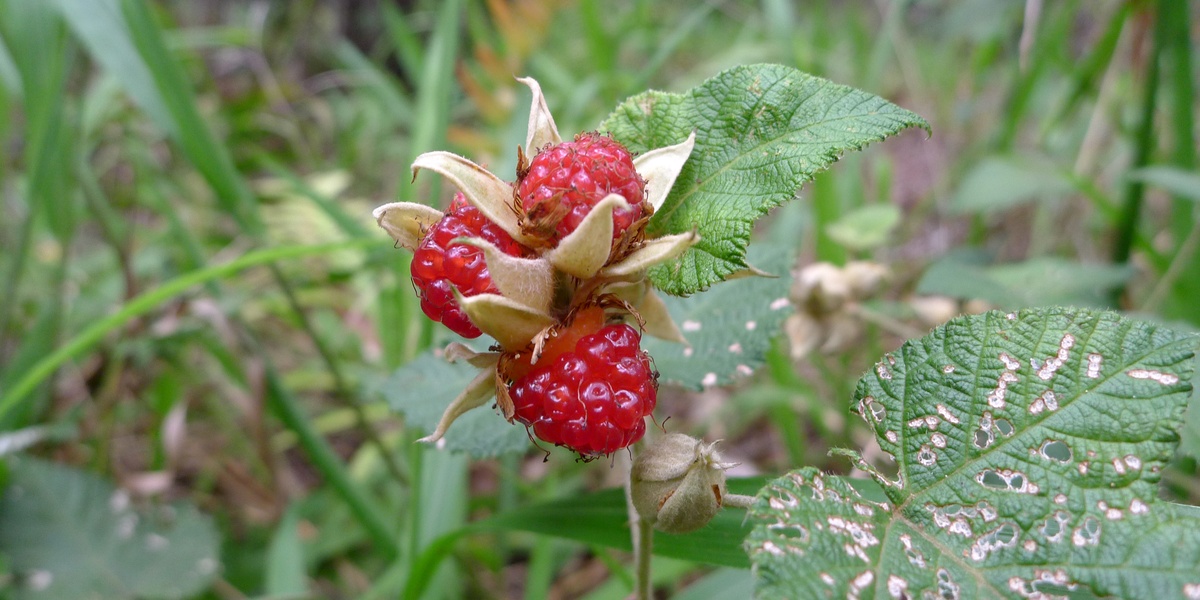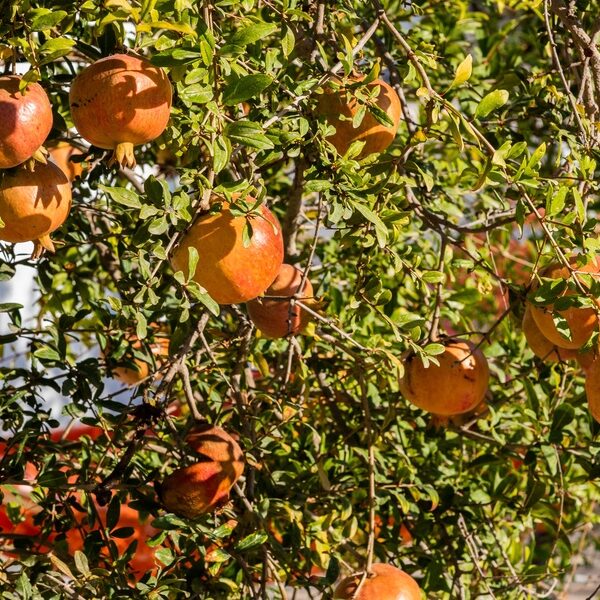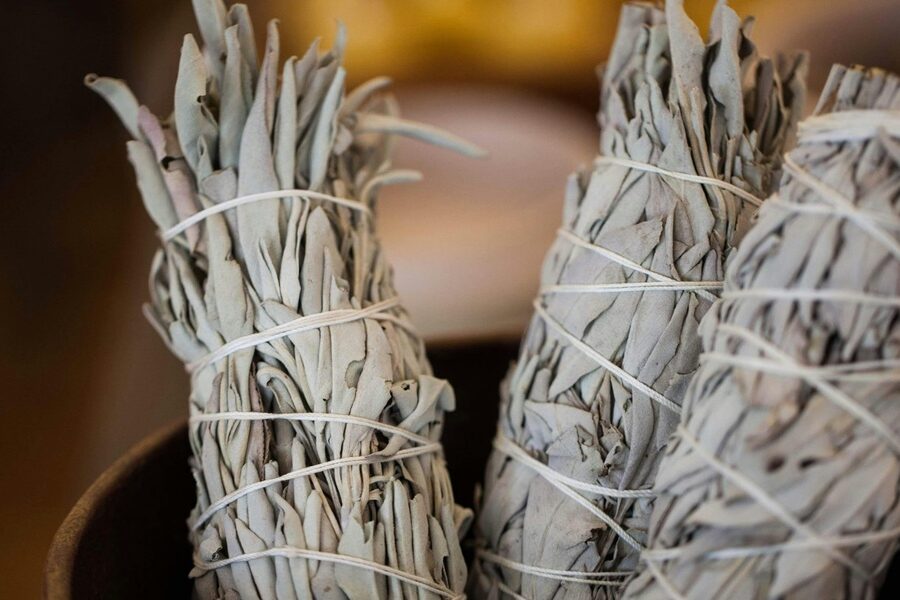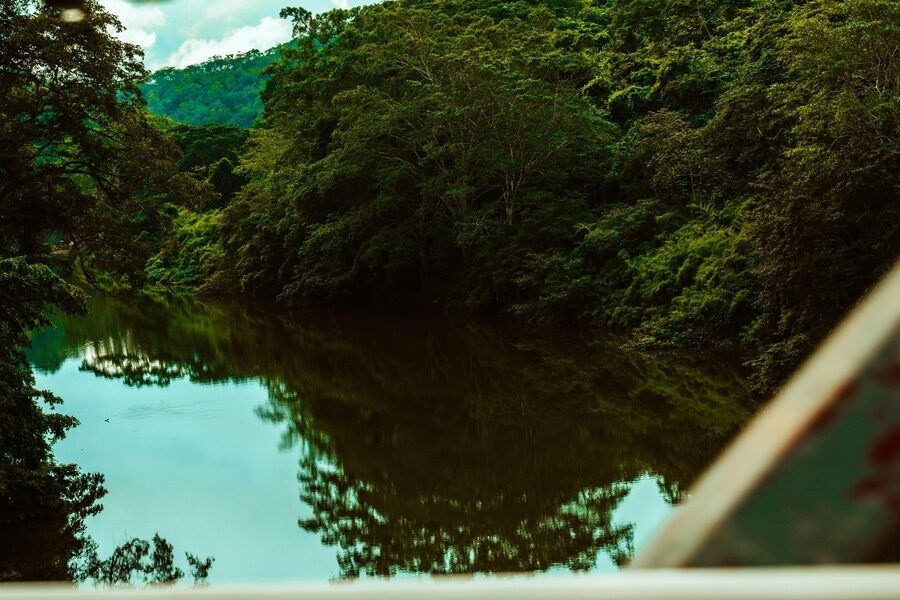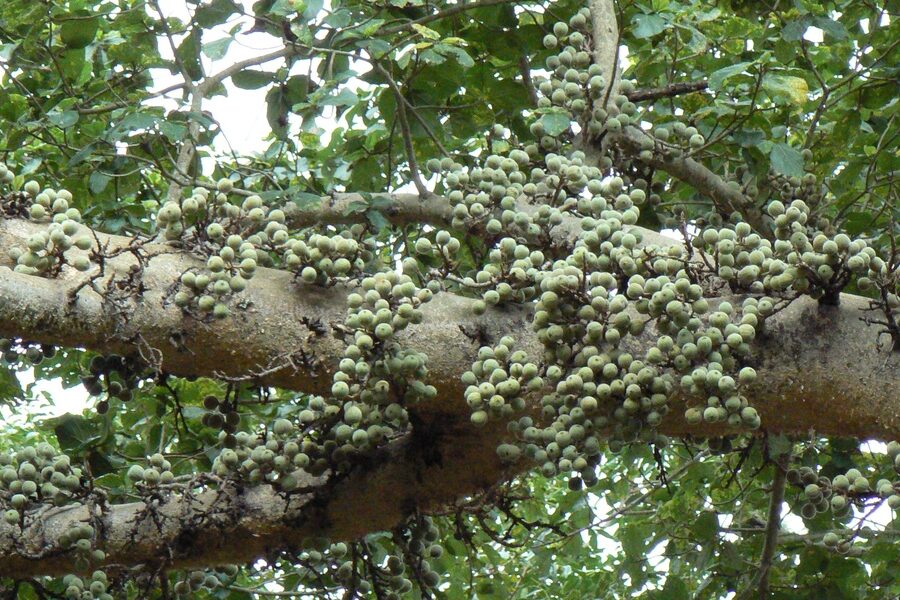You can learn a lot about a place by walking through its woods: the understory changes with the seasons, wildlife follows fruiting patterns, and small details like bark or leaf shape help you find food and medicine. This list collects the kinds of fruit that show up in temperate forests and points out where they tend to grow.
There are 48 forest fruits, ranging from Acorn to Wintergreen. Each entry is organized with Scientific name, Edibility, Habitat & season so you can identify and use them — you’ll find below.
How can I tell which forest fruits are safe to eat?
Start with clear field marks (shape, color, leaves, and where the plant grows) and cross-check the Scientific name in a reliable guide; if a plant is unknown or has toxic look-alikes, don’t taste it. Note that edibility can vary by preparation and age of the fruit.
When is the best time to forage these fruits?
Timing depends on species and region: many berries peak in mid to late summer, nuts ripen in fall, and some fruits persist into winter. Check the Habitat & season column for each item and look for local foraging reports for exact timing.
Forest Fruits
| Name | Scientific name | Edibility | Habitat & season |
|---|---|---|---|
| Wild Strawberry | Fragaria vesca | Edible. Delicious raw, in desserts, or made into jams. Leaves used for tea. | Open woods, forest edges, and clearings; May–July. |
| Wild Raspberry | Rubus idaeus | Edible. Excellent eaten fresh, in jams, pies, and sauces. Rich in vitamins. | Woodland clearings, forest edges, and disturbed areas; July–September. |
| Wild Blackberry | Rubus fruticosus agg. | Edible. Eaten raw or cooked into pies, crumbles, jams, and wines. | Hedgerows, woodland edges, and thickets; August–October. |
| Elderberry | Sambucus nigra | Use caution. Ripe black berries are edible only when cooked. Raw berries are toxic. Flowers are edible. | Damp woods, hedgerows, and forest margins; August–September. |
| Saskatoon Berry | Amelanchier alnifolia | Edible. Sweet and nutty. Eaten fresh, dried, or in pies and jams. | Open woods, forest edges, and riverbanks across North America; June–July. |
| Huckleberry | Vaccinium spp. / Gaylussacia spp. | Edible. Eaten raw, in pies, jams, and pancakes. A prized wild fruit. | Coniferous or mixed forests with acidic soil; July–September. |
| Wild Blueberry | Vaccinium angustifolium | Edible. Eaten fresh, frozen, or in pies, muffins, and jams. | Acidic soils in open conifer or mixed-wood forests; July–September. |
| Bilberry | Vaccinium myrtillus | Edible. Eaten fresh or used in pies, jams, and traditional medicines. | Heathlands and acidic soils in coniferous forests across Eurasia; July–September. |
| Lingonberry | Vaccinium vitis-idaea | Edible. Very tart. Typically cooked into sauces, jams, and syrups. | Boreal forests and arctic tundra with acidic soil; August–October. |
| Wild Cranberry | Vaccinium oxycoccos | Edible. Extremely tart; best cooked with sugar for sauces, jellies, and drinks. | Acidic bogs, muskegs, and damp forest floors; September–November. |
| Rose Hip | Rosa spp. | Edible. Tart and high in Vitamin C. Used for tea, syrup, and jelly. | Forest edges, hedgerows, and open woodlands; September–December. |
| Hawthorn Berry | Crataegus spp. | Edible. Tart and tangy. Best cooked into jellies, wines, or sauces. | Woodlands, hedgerows, and forest margins; September–November. |
| Rowan Berry | Sorbus aucuparia | Use caution. Edible only when cooked; raw berries are mildly toxic and bitter. | Mountain forests and woodlands; September–October. |
| Crabapple | Malus spp. | Edible. Very sour and astringent. Best cooked into jellies, cider, and butter. | Deciduous forests and woodland edges; September–November. |
| Wild Plum | Prunus americana | Edible. Sweet and tart. Eaten fresh or made into jams, jellies, and fruit leather. | Thickets, woodland borders, and stream banks; August–September. |
| Black Cherry | Prunus serotina | Edible. Fruit is edible; pits, leaves, and stems are toxic. Used in jams and wine. | Deciduous and mixed forests; August–September. |
| Chokecherry | Prunus virginiana | Use caution. Fruit is edible; pits and leaves are toxic. Very astringent raw. | Woodlands, thickets, and riverbanks; August–September. |
| Pawpaw | Asimina triloba | Edible. Custard-like texture with a tropical flavor. Eaten fresh. | Rich, moist soil in deciduous forest understories; September–October. |
| American Persimmon | Diospyros virginiana | Edible. Very sweet when fully ripe; inedible and astringent when unripe. | Bottomland forests and upland woods; September–December. |
| Mulberry | Morus rubra | Edible. Sweet and juicy. Eaten fresh from the tree or in pies and jams. | Rich woods, river bottoms, and forest edges; June–August. |
| Hackberry | Celtis occidentalis | Edible. Thin pulp tastes like a date. Eaten raw or ground into meal. | Moist bottomlands and limestone soils in forests; September–November. |
| Nannyberry | Viburnum lentago | Edible. Sweet, date-like flavor. Eaten raw or cooked into preserves. | Moist woods, streambanks, and forest edges; September–October. |
| Highbush Cranberry | Viburnum opulus var. americanum | Edible. Very tart. Used for jellies and sauces. Not a true cranberry. | Moist woods and swamps; September–October. |
| Bunchberry | Cornus canadensis | Edible. Mildly sweet, mealy texture. Eaten raw as a trailside nibble. | Cool, moist soils on the floor of boreal and mixed-wood forests; August–September. |
| Salal Berry | Gaultheria shallon | Edible. Mildly sweet and mealy. Eaten raw, dried into cakes, or made into jam. | Coniferous forest understory in the Pacific Northwest; August–September. |
| Oregon Grape | Mahonia aquifolium | Edible. Extremely tart. Best made into jelly or mixed with sweeter fruits. | Coniferous forest understories and clearings in western North America; August–September. |
| Salmonberry | Rubus spectabilis | Edible. Mildly sweet and watery. Eaten fresh. | Moist, coastal forests and streambanks in the Pacific Northwest; May–July. |
| Thimbleberry | Rubus parviflorus | Edible. Delicate and tart. Best eaten fresh from the bush. | Forest edges, clearings, and roadsides; July–August. |
| Cloudberry | Rubus chamaemorus | Edible. A prized delicacy. Tart and unique. Made into jams and liqueurs. | Peat bogs and wet tundra in circumpolar boreal forests; July–August. |
| Partridgeberry | Mitchella repens | Edible. Bland and seedy. Eaten raw but not highly prized for flavor. | Forest floors, often under pines or hemlocks; Persists year-round. |
| Wintergreen | Gaultheria procumbens | Edible. Strong, minty flavor. Eaten raw or used to flavor teas and desserts. | Acidic soil in oak and conifer forests; Persists year-round. |
| Bearberry | Arctostaphylos uva-ursi | Edible. Mealy, dry, and bland. Primarily a survival food or medicinal. | Dry, sandy, or rocky soils in boreal and arctic forests; August–September. |
| Crowberry | Empetrum nigrum | Edible. Juicy but bland. A survival food, better when cooked or frozen. | Alpine meadows, tundra, and boreal forests; August–September. |
| Spicebush | Lindera benzoin | Edible. Berries are dried and used as an allspice substitute. Leaves for tea. | Moist, rich woods and streambanks in eastern North America; September. |
| Mayapple | Podophyllum peltatum | Use caution. Ripe fruit is edible; all other parts are toxic. Eaten fresh. | Rich, deciduous woodlands in eastern North America; July–August. |
| Acorn | Quercus spp. | Use caution. Must be leached of tannins before eating. Ground into flour. | Oak forests and woodlands worldwide; September–November. |
| Black Walnut | Juglans nigra | Edible. Rich, oily, and intensely flavored nut. Eaten raw or in baking. | Rich, deep soils in deciduous forests of eastern North America; October–November. |
| Butternut | Juglans cinerea | Edible. Oily, sweet, and buttery nut. Eaten raw or used in baked goods. | Rich, moist soils in mixed hardwood forests; September–October. |
| Shagbark Hickory Nut | Carya ovata | Edible. Sweet and rich, similar to pecan. Eaten raw or in pies. | Upland woods and bottomlands in eastern North America; September–November. |
| American Hazelnut | Corylus americana | Edible. Sweet and versatile nut. Eaten raw, roasted, or ground into flour. | Thickets, woodland borders, and clearings; August–September. |
| Beechnut | Fagus grandifolia | Edible. Small, sweet triangular nut. Eaten raw or roasted. | Mature beech forests in eastern North America; September–October. |
| Pine Nut | Pinus spp. | Edible. Rich, oily, and buttery. Eaten raw, roasted, or in pesto. | Various pine forests, especially Pinyon pines in the American Southwest; September–November. |
| American Chestnut | Castanea dentata | Edible. Sweet and starchy nut. Eaten roasted or ground into flour. | Historically, Appalachian hardwood forests; September–October. |
| Red Baneberry | Actaea rubra | Poisonous. Ingestion causes severe gastrointestinal distress and cardiac symptoms. | Rich, moist deciduous or mixed forests; July–September. |
| White Baneberry | Actaea pachypoda | Poisonous. Highly toxic. Ingestion can lead to cardiac arrest and death. | Rich, moist hardwood forests; July–September. |
| Moonseed | Menispermum canadense | Poisonous. Contains toxins that can be fatal. A dangerous wild grape lookalike. | Moist woods, thickets, and streambanks; September–October. |
| Pokeweed | Phytolacca americana | Poisonous. Berries and mature plant parts are highly toxic. Roots are deadliest. | Disturbed areas, forest edges, and fields; August–October. |
| Deadly Nightshade | Atropa belladonna | Poisonous. Extremely toxic. Ingestion of a few berries can be fatal to a child. | Shady areas, often in disturbed soil in woodlands in Europe; June–September. |
Images and Descriptions
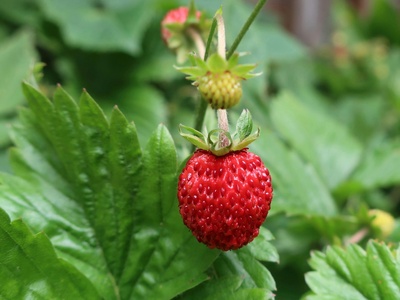
Wild Strawberry
A low-growing plant with familiar three-lobed leaves, producing small, intensely flavored red berries. Far more aromatic and flavorful than commercial strawberries, they are a true forager’s treat. Look for them in sunny patches on the forest floor.
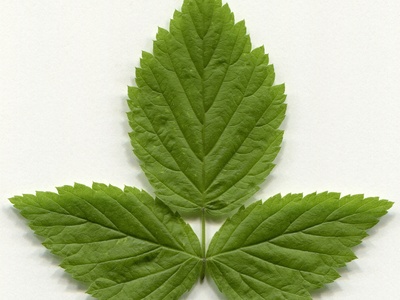
Wild Raspberry
These familiar red berries grow on thorny canes (brambles). The fruit is a composite of tiny drupelets and pulls easily away from its white core when ripe. Their sweet, tart flavor is a classic sign of summer in the woods.
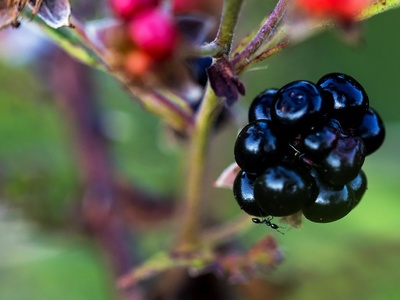
Wild Blackberry
A sprawling, thorny shrub that produces large, dark purple-to-black berries. Unlike raspberries, the core remains inside the fruit when picked. The berries are juicy, sweet, and slightly tart, ripening in late summer and providing a feast for wildlife.
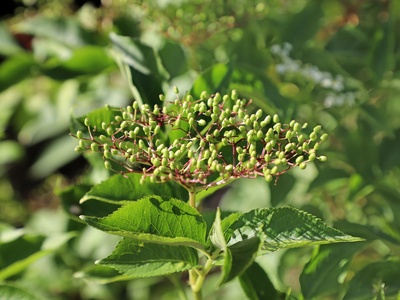
Elderberry
Large shrubs with clusters of tiny white flowers that become drooping bunches of dark purple-black berries. Cooked berries are used for syrup, wine, and pies to boost immunity. Never eat unripe (green) or raw berries, as they contain cyanide-inducing glycosides.
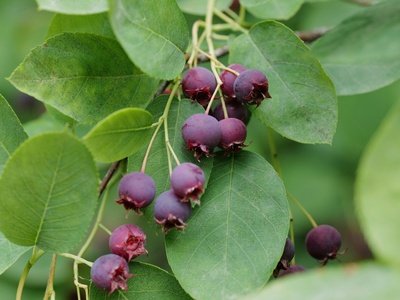
Saskatoon Berry
Also known as Serviceberry or Juneberry, this shrub produces small, round, purple berries that resemble blueberries. They have a unique sweet, almond-like flavor. The berries were a vital food source for Indigenous peoples and are a favorite of birds.
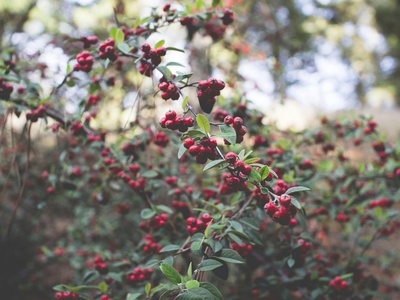
Huckleberry
These small, round berries range from red to deep blue-black, depending on the species. They grow on shrubs and are a staple for bears. Huckleberries are known for their intense, sweet-tart flavor that captures the essence of the wild.
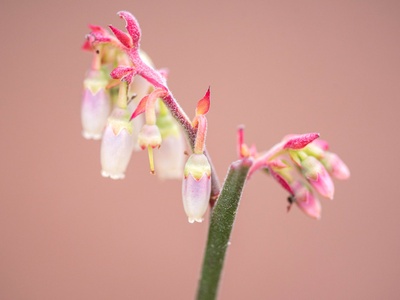
Wild Blueberry
These low-bush berries are smaller and more intensely flavored than their cultivated cousins. Their dusty blue skin covers a sweet, juicy interior. Look for the five-pointed star or crown on the blossom end, a key feature of the Vaccinium genus.
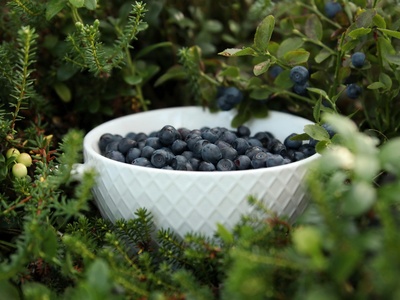
Bilberry
A close cousin of the blueberry, also called whortleberry. The small, dark blue berries grow singly or in pairs on low shrubs. They have a more intense, tangy flavor than blueberries and will stain your hands and mouth a deep purple.
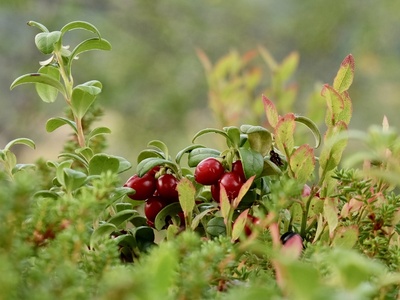
Lingonberry
A low, evergreen shrub producing bright red, tart berries. Too sour to eat raw for most, they are famously made into a sauce served with game meats in Scandinavian cuisine. Their tartness mellows beautifully with sugar and cooking.
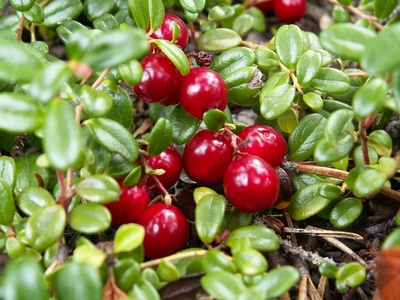
Wild Cranberry
These small, red berries grow on low, creeping vines in boggy, wet areas. They are much smaller and tarter than commercial cranberries. Their sharp flavor makes them a perfect ingredient for holiday sauces or as a zesty addition to baked goods.
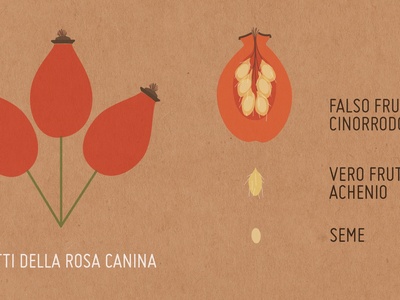
Rose Hip
The reddish-orange fruit of the rose plant, best harvested after the first frost, which softens them and increases their sweetness. The outer flesh is edible, but the hairy seeds inside must be removed before consumption as they are an irritant.
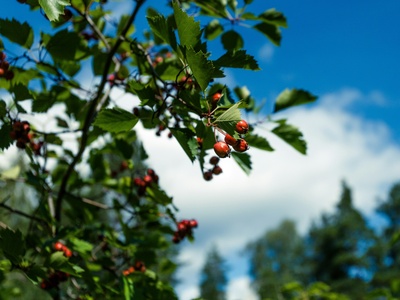
Hawthorn Berry
Small, bright red berries (pomes) that grow in clusters on thorny trees. The flesh is dry and mealy, surrounding a hard stone. While not great raw, they have a lovely apple-like flavor when cooked and are used in traditional heart tonics.
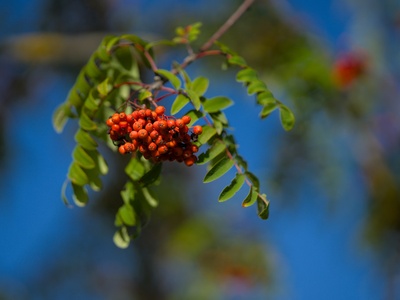
Rowan Berry
Also known as Mountain Ash, this tree produces clusters of vibrant orange-red berries. Raw berries contain parasorbic acid, which causes stomach upset, but cooking breaks it down. They make a bitter, vitamin-rich jelly that pairs well with game.
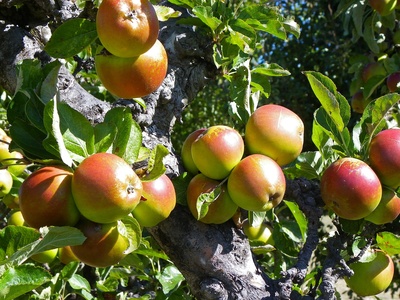
Crabapple
Small, wild apples that are intensely sour and often hard. While unpalatable raw, their high pectin and acid content make them perfect for setting jellies and adding a sharp, apple flavor to preserves and homemade ciders.
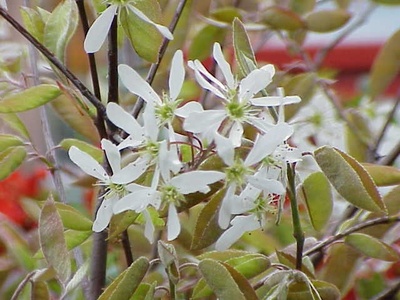
Wild Plum
Small, round to oval fruits ranging from yellow to deep red. The skin is tart, but the flesh is sweet and juicy. These plums grow on thorny shrubs or small trees and make for a delicious and refreshing trailside snack.
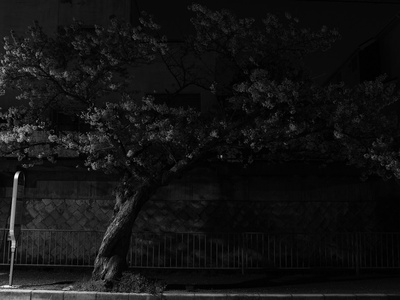
Black Cherry
A large tree that produces long, drooping clusters of dark reddish-black cherries. The fruit is small with a large pit but has a rich, bittersweet, and slightly astringent flavor perfect for flavoring wines, jams, and desserts.
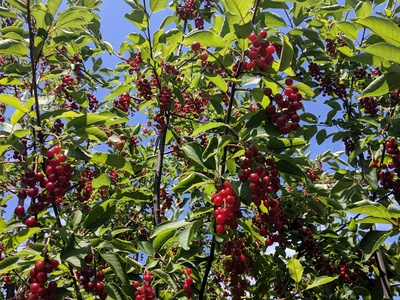
Chokecherry
Shrubs or small trees with dark red to black berries in elongated clusters. Extremely astringent and puckering raw, hence the name. When cooked with sugar, they make fantastic syrups, jellies, and wines with a deep, complex cherry flavor.
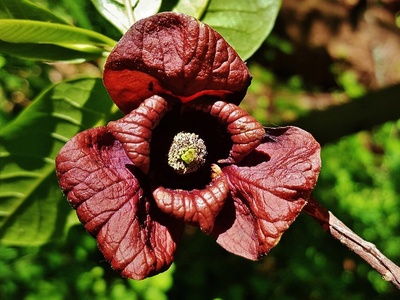
Pawpaw
North America’s largest native fruit, the pawpaw has a creamy, soft texture and a unique flavor like a mix of banana, mango, and pineapple. The greenish-yellow fruit is often hidden by large leaves and should be eaten when soft to the touch.
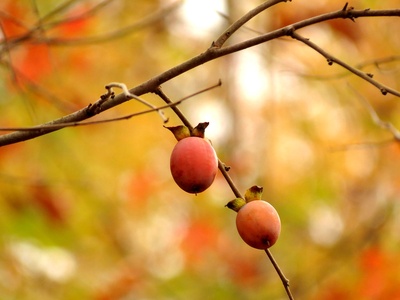
American Persimmon
This fruit is only edible after it becomes extremely soft, almost mushy, often after the first frost. An unripe persimmon is incredibly astringent. A ripe one is a treat, with a sweet, honey-like flavor and a date-like texture.
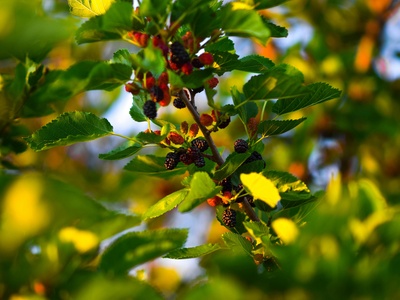
Mulberry
These berries resemble elongated blackberries and grow on trees, not brambles. They ripen from red to a deep, dark purple and are very sweet and juicy with a mild flavor. They stain everything, so handle with care!
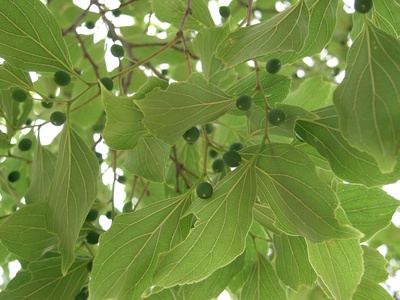
Hackberry
A small, berry-like drupe with a thin, sweet, date-like pulp surrounding a large, hard pit. The fruit ripens to a dark purple and often persists on the tree into winter, providing a valuable survival food.
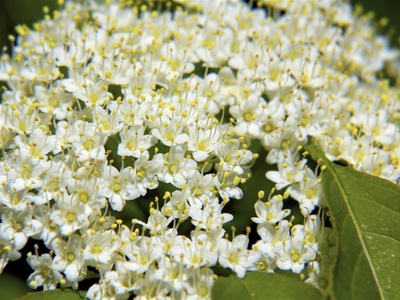
Nannyberry
A large shrub producing clusters of bluish-black, oval berries. The pulp is sweet and pruney, but thin over a large seed. The berries sweeten after a frost and were named for their scent, which is said to resemble a wet goat.
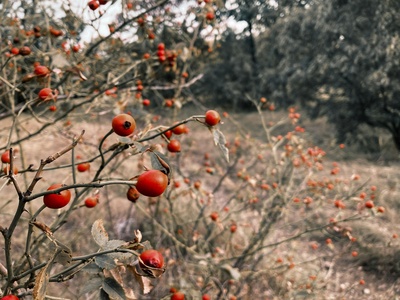
Highbush Cranberry
This tall shrub produces clusters of bright red, translucent berries, each containing a single flat seed. They are too tart to eat raw but make a fantastic, brightly colored jelly or sauce with a flavor similar to true cranberries.
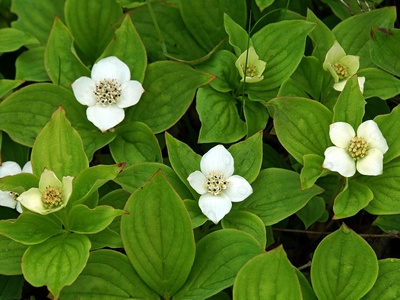
Bunchberry
A low-growing dogwood with a whorl of leaves and a cluster of bright red berries. The fruit is more interesting than delicious, with a soft, mealy texture and a large pit. It offers a subtle sweetness and is a pretty sight on the forest floor.
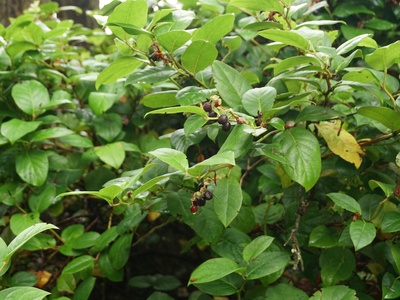
Salal Berry
A common evergreen shrub in coastal forests, producing dark blue-to-black, hairy berries. They have a unique, mild, sweet flavor and a slightly mealy texture. They were a cornerstone food for coastal Indigenous peoples.
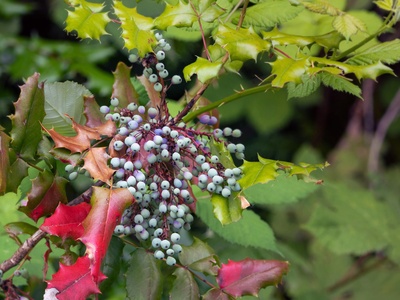
Oregon Grape
This evergreen holly-like shrub produces dusty, blue, spherical berries in grape-like clusters. They are intensely sour but rich in pectin, making them excellent for jelly. The plant’s roots are also used in herbal medicine.
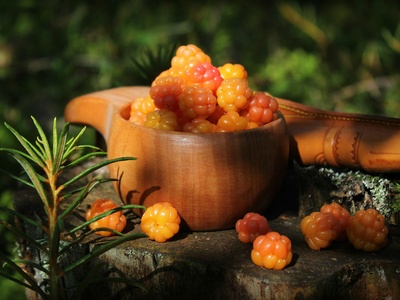
Salmonberry
One of the earliest berries to ripen, salmonberries resemble large, shiny raspberries and range in color from salmon-pink to deep red. They have a delicate, mild flavor and a soft texture. The young green shoots can also be eaten in spring.
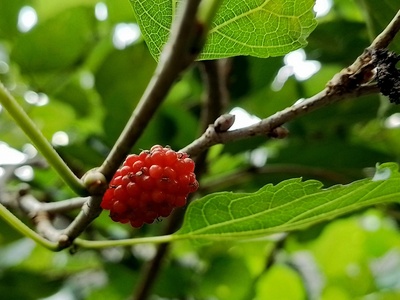
Thimbleberry
A soft, bright red berry that resembles a wide, flat raspberry or a thimble. It has a wonderfully tart and intense flavor but is so delicate that it falls apart easily, making it a treat best enjoyed right where you find it. The plant has no thorns.
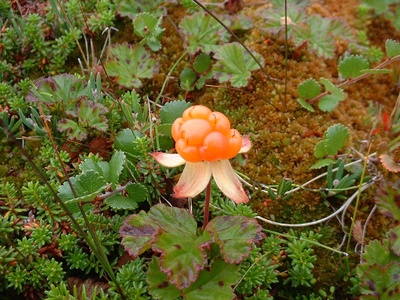
Cloudberry
A rare and sought-after berry that grows one per stem. It ripens from red to a soft, amber color. Cloudberries have a unique taste that is both tart and creamy. They are a treasure of northern forests and a staple in Scandinavian cuisine.
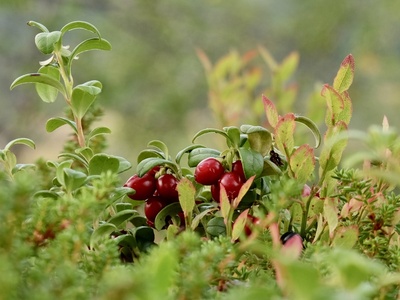
Partridgeberry
A creeping vine with small, opposite evergreen leaves and a single bright red berry. The berry is actually two fused ovaries, identifiable by two dimples on its surface. It’s edible but has little flavor and a seedy texture.
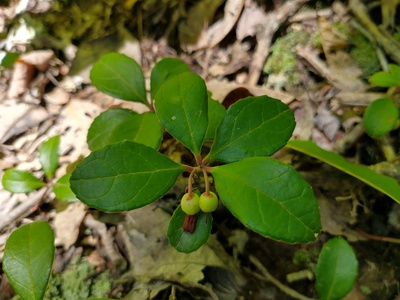
Wintergreen
Also called Teaberry. A low-growing plant with waxy leaves and a bright red, berry-like fruit that tastes exactly like wintergreen. The leaves and fruit can be nibbled for a refreshing trailside treat or used to make a minty tea.
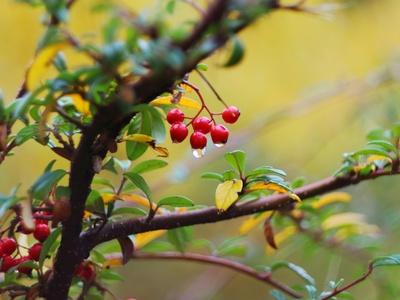
Bearberry
Also known as Kinnikinnick. A low, trailing evergreen with small, tough leaves and bright red berries. The fruit is mealy and tasteless but a good survival food. The leaves are more famously used in traditional smoking mixtures and as a urinary antiseptic.
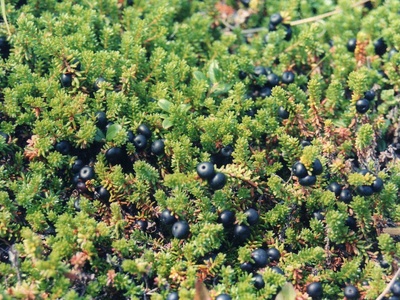
Crowberry
A low, mat-forming evergreen shrub with needle-like leaves and shiny, black berries. The fruit is juicy but lacks strong flavor. It becomes sweeter after a frost and can be mixed with other berries or used to make juice and jelly.
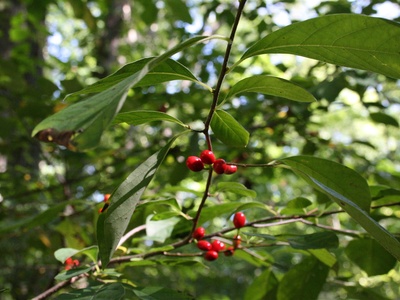
Spicebush
A deciduous shrub whose bright red, oval berries have a spicy, aromatic flavor. When dried and ground, they make an excellent substitute for allspice. The leaves and twigs also have a spicy fragrance and can be made into a flavorful tea.
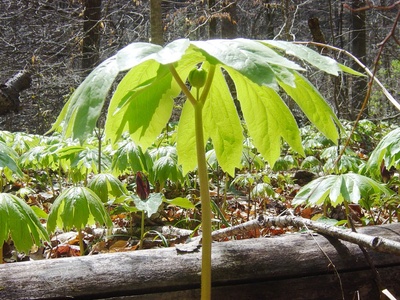
Mayapple
A unique plant with large, umbrella-like leaves hiding a single flower. A ripe, yellow, soft fruit is edible and has a tropical, aromatic flavor. Unripe fruit and all other parts of the plant are poisonous. Forage with extreme care.
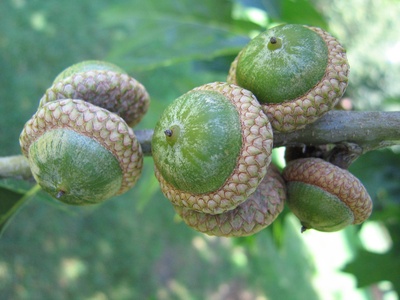
Acorn
The nut of the oak tree. Raw acorns are bitter and toxic due to high levels of tannic acid. After leaching in water to remove the tannins, they can be dried and ground into a nutritious, gluten-free flour for bread, porridge, or coffee.
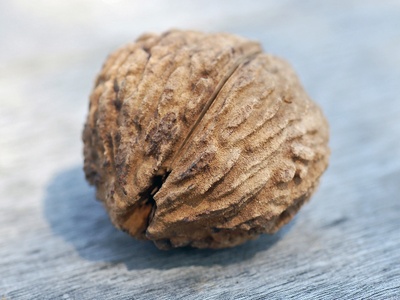
Black Walnut
A large, green-husked nut that contains a deeply ridged, hard shell. The nutmeat inside is oily, with a bold, earthy flavor much stronger than English walnuts. The dark husk will stain everything it touches a deep brown.
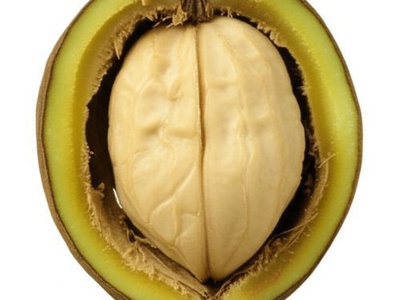
Butternut
Also called white walnut, this large nut has a sticky, greenish-yellow husk and a deeply ridged, oblong shell. The nutmeat is sweet, oily, and delicious, prized for its buttery flavor. The tree is unfortunately threatened by a fungal canker.
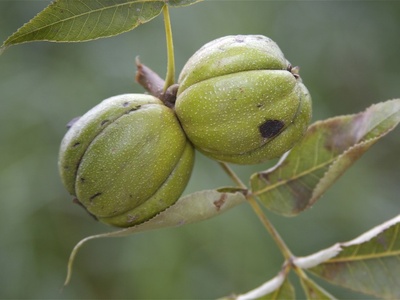
Shagbark Hickory Nut
Named for its distinctive shaggy, peeling bark. The nuts have a thick, woody husk and a hard, four-ribbed shell. The nutmeat is sweet and flavorful, considered by many to be one of the best-tasting wild nuts, rivaling the pecan.
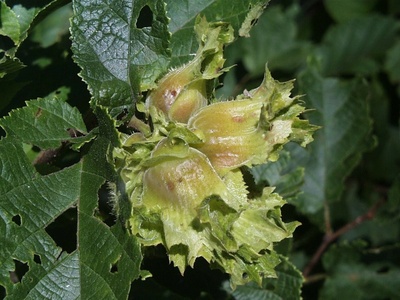
American Hazelnut
A multi-stemmed shrub that produces nuts in clusters, each enclosed in a leafy, ragged husk called an involucre. The nuts are smaller than commercial hazelnuts but have a wonderful, sweet flavor. They are a favorite of squirrels, so get them early!
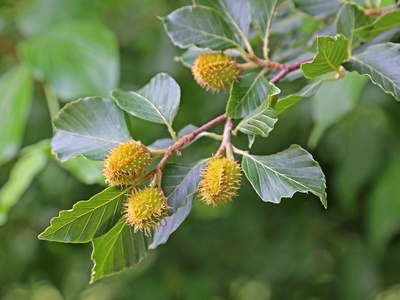
Beechnut
Found inside a spiky, four-lobed husk, beechnuts are small, three-sided nuts. They have a sweet, rich flavor, especially after roasting. Production is cyclical, with “mast years” yielding a heavy crop every few years.
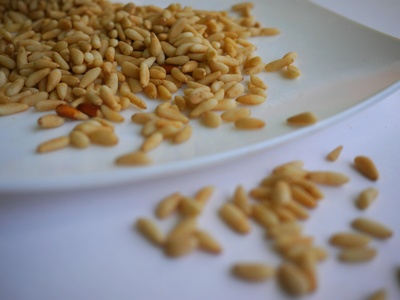
Pine Nut
Harvested from the cones of certain pine species. The small, tear-drop shaped nuts have a delicate, buttery flavor and are high in protein and fat. Harvesting them from the sticky cones is a labor of love rewarded with a delicious treat.
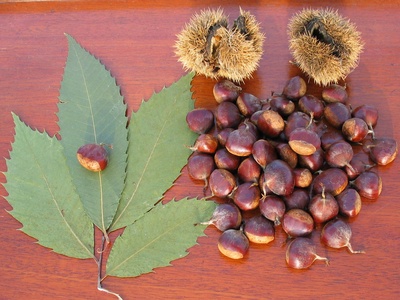
American Chestnut
Once a dominant tree, now mostly found as small, sprouting stumps due to blight. The nuts grow in a formidably spiny bur. They are sweet and starchy, excellent for roasting. Finding a fruiting tree is a rare and special event.
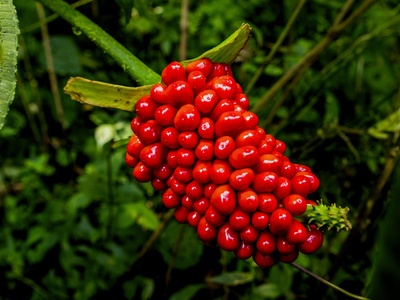
Red Baneberry
A herbaceous woodland plant with clusters of shiny, bright red berries. Each berry has a noticeable dark dot on the end. The entire plant is highly toxic. Its vibrant color is a clear warning to foragers to leave it alone.
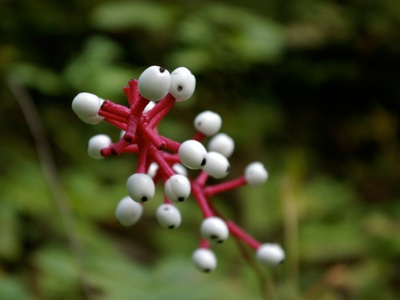
White Baneberry
Also known as Doll’s Eyes, this plant has a cluster of striking white berries, each with a prominent black dot, on a thick pinkish stalk. Like its red-berried relative, it is extremely poisonous and should never be consumed.
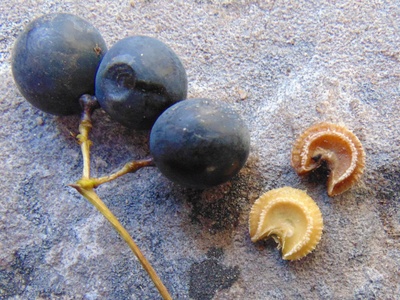
Moonseed
This climbing vine produces clusters of dark purple berries that look like wild grapes. The key identifier is the seed: moonseed has a single, crescent-moon-shaped seed, while grapes have multiple small, round seeds. This is a deadly lookalike.
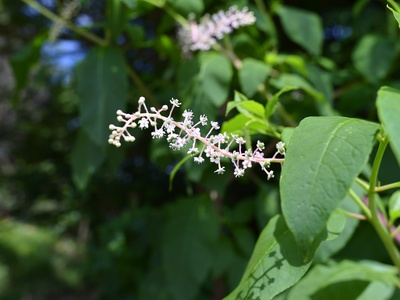
Pokeweed
A large, herbaceous plant with a distinctive purplish-red stem and drooping clusters of dark purple berries. While young shoots (poke sallet) are a traditional food after careful boiling, the vibrant berries are toxic and should not be eaten.
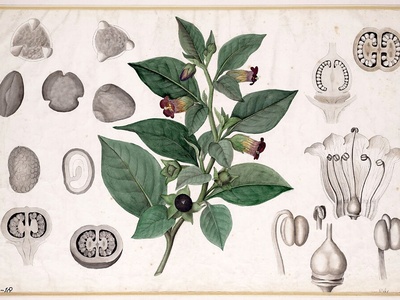
Deadly Nightshade
A bushy plant with dull green leaves and bell-shaped, purplish flowers that mature into single, shiny, black berries. The berry is slightly sweet, making it dangerously appealing. All parts of the plant contain tropane alkaloids and are deadly.
